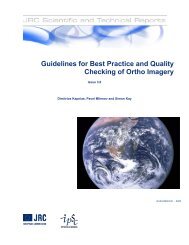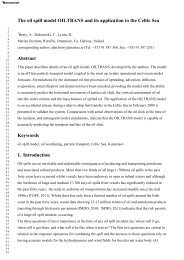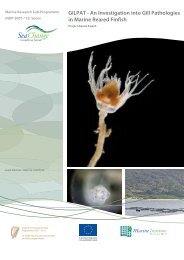Irish Shipping and Ports Requirements for the Ocean Energy Industry
Irish Shipping and Ports Requirements for the Ocean Energy Industry
Irish Shipping and Ports Requirements for the Ocean Energy Industry
You also want an ePaper? Increase the reach of your titles
YUMPU automatically turns print PDFs into web optimized ePapers that Google loves.
Manufacture <strong>and</strong> foundation productionDue to market growth <strong>and</strong> <strong>the</strong> large size of turbines, wind-turbine manufacturers have been lookingtowards European portside turbine assembly facilities. More recently three large port developmentsat Sheerness, Hull <strong>and</strong> Belfast have been announced as potential assembly facilities. Roadtransportation is becoming less viable <strong>for</strong> completed nacelles, <strong>and</strong> offshore turbines need to beshipped by sea at some point <strong>for</strong> installation. It also makes sense to manufacture large components(such as castings) close to turbine manufacture.Particular requirements will vary depending on <strong>the</strong> activity being undertaken; however, in generalterms, manufacturing facilities at port locations will require substantial areas of development l<strong>and</strong>with good transport links <strong>and</strong> need to be well served by associated support services including supplyindustries <strong>and</strong> research <strong>and</strong> development.Whe<strong>the</strong>r steel monopiles, concrete gravity bases, or jacket or tripod structures, all offshore windfoundations are very large <strong>and</strong> once produced can only be transported by water. Much expansion ofproduction capacity will be required to meet future dem<strong>and</strong>; hence it is likely that new coastallocations <strong>for</strong> foundation manufacture will be established. Compared with set-up times relating too<strong>the</strong>r elements of <strong>the</strong> value chain, foundation manufacturing facilities can be set up relatively quickly.Construction <strong>and</strong> installationIndividual phases of a construction project may be operated by a specialist offshore contractor orwindfarm developer, or by <strong>the</strong> wind-turbine manufacturer offering a turnkey service. Port stevedoring<strong>and</strong> operation may be managed by <strong>the</strong> port owner or <strong>the</strong> site occupier.Typical activities during <strong>the</strong> topside installation phase include:Unloading in-bound components from supply vessels, such as towers, hubs, blades <strong>and</strong>nacellesLaying down products to ensure <strong>the</strong>ir availability when wea<strong>the</strong>r <strong>and</strong> vessel availability allowsconstruction to proceedInstalling turbines in batches, based on vessel capacity:ooooAssembling of tower sections <strong>and</strong> loading on to <strong>the</strong> installation vessel, which may involvevertical <strong>and</strong>/or horizontal loading, hence <strong>the</strong> high air-draft requirementsFitting two blades to each nacelle where <strong>the</strong> ‘bunny ears’ configuration is used, or fittingall three blades to <strong>the</strong> hub, with rotor horizontalPreparing <strong>and</strong> loading nacelles on to <strong>the</strong> installation vesselPreparing <strong>and</strong> loading remaining blades on to <strong>the</strong> installation vesselTypical requirements <strong>for</strong> port facilities to support an installation of 100 turbines per year would be:24-hour access200–300m length of quayside with high load-bearing capacity <strong>and</strong> adjacent access quay bearing capacity of typically 3 to 6 ton/m 2 , but in some cases may be up to 10 ton/m 2
















